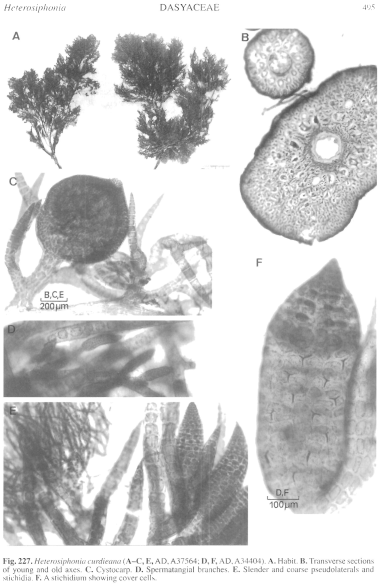|
|
|
|
|
|||||||||||
|
Electronic Flora of South Australia Species Fact Sheet
Phylum Rhodophyta – Order Ceramiales – Family Dasyaceae
Selected citations: De Toni 1903: 1236. Falkenberg 1901: 716. Lucas 1912: 159; 1929b: 52. Lucas & Perrin 1947: 318.
Synonym
Dasya curdieana Harvey in J. Agardh 1863: 1189; 1890a: 87. Sonder 1881: 36.
Thallus (Fig. 227A) dark red-brown, erect, 10–30 cm high, with a single axis bearing long lateral branches 2–3 (–4) mm in diameter, heavily corticated and denuded over lower half or more (probably perennial with annual re-growth). Branches bearing relatively slender laterals 2–5 cm long, with distichous pseudolaterals. Holdfast discoid, 2–10 cm across; epilithic. Structure. Apices of axes sympodial and distichous, developing (12–) 13 pericentral cells (Fig. 227B) commencing shortly below the apical cell. Pseudolaterals 4–5 segments apart, 2–3 mm long, each with subdichotomous, more or less distichous, coarse branches (2–) 3–4 segments apart, becoming polysiphonous (5–8 pericentral cells) but with monosiphonous terminal branches, cells tapering abruptly to an acute end cell (Fig. 227C, D, right), some pseudolaterals developing markedly slender terminal tufts (Fig. 227E, left); monosiphonous branches 90–120 µm in diameter, cells L/D 0.7–1.2, but the slender filaments basally 35–45 µm in diameter, cells L/D 1.5–2, tapering gradually to upper cells 10–12 µm in diameter and L/D 4–7. Cortication commencing on polysiphonous lower segments of pseudolaterals from small cells cut off pericentral cells, developing rapidly and on axes and lateral branches forming a pseudoparenchymatous cortex 0.7–1.5 mm and many cells thick, with smaller cells between the prominent axial cell and the ring of pericentral cells; outer cortex without anticlinal filaments. Rhodoplasts discoid to elongate or in chains in axial cells.
Reproduction: Gametophytes dioecious. Procarps unknown. Cystocarps (Fig. 227C) large and prominent, ovoid, 1.5–2 mm in diameter, with a slight neck, sessile on polysiphonous branches; pericarp dense, with an outer layer of irregular cells; carposporophytes much branched, with a basal fusion cell and rows of ovoid carposporangia, 20–45 µm in diameter. Spermatangial branches (Fig. 227D) developed as terminal branches of the slender monosiphonous tufts, 90–120 µm long and 30–40 µm in diameter.
Tetrasporangial stichidia (Fig. 227E, F) situated on lower polysiphonous branches of coarse pseudolaterals, lanceoid to cylindrical, 400–1400 µm long and 200–280 µm in diameter, with 6 sporangia per whorl, each with 2 pre-sporangial cover cells (Fig. 227F) divided horizontally, largely covering the sporangia; tetrasporangia 60–90 µm in diameter.
Type from S. Australia (Curdie); holotype in Herb. Agardh, LD, 43802. Distribuiton: Eyre, W. Aust., to Nora Creina, S. Australia.
Selected specimens: Eyre, W. Aust., drift (Parsons, 22.xi.1968; AD, A34404). Elliston, S. Aust., 7 m deep (Shepherd, 21.x.1970; AD, A37564). Almonte Beach, Avoid Point, S. Aust., drift (Lawrence, 21.i.1977; AD, A47851). Sturt Bay, S. Aust., drift (Davey; AD, A1476). Tapley Shoal, S. Aust., 15 m deep (Shepherd, 2.ii.1969; AD, A33531). Granite I., Victor Harbor, S. Aust., 7–10 m deep (Edyvane, 8.viii.1982; AD, A53196). Port Elliot, S. Aust., drift (Woelkerling, 10.xii.1968; AD, A33345). Vivonne Bay, Kangaroo I., S. Aust., drift (Womersley, 2.i.1949; AD, Al 0667). Pennington Bay, Kangaroo I., S. Aust., drift (Kraft & Min Thein, 3.xii.1971; AD, A41388). Cape Jaffa, S. Aust., drift (Womersley, 25.xi.1992; AD, A61790). Stinky Bay, Nora Creina, S. Aust., drift (Womersley, 7.xi.1965; AD, A29641).
Taxonomic notes: H. curdieana is a distinctive species, in size and in the heavily corticated, bare, axes and lower branches (probably perennial) bearing tufts of small branches and coarse pseudolaterals. It is probably a deep-water species.
There are 2 Curdie specimens in Herb. Harvey, TCD, bearing Harvey's name, and one in LD, from which J. Agardh described the species.
References:
AGARDH, J.G. (1863). Species Genera et Ordines Algarum. Vol. 2, Part 3, pp. 787–1291. (Gleerup: Lund.)
AGARDH, J.G. (1890a). Till algernes systematik. Acta Univ. lund. 26(3), 1–125, Plates 1–3.
DE TONI, G.B. (1903). Sylloge Algarum omnium hucusque Cognitarum. Vol. 4. Florideae. Sect. 3, pp. 775–1521 + 1523–1525. (Padua.)
FALKENBERG, P. (1901). Die Rhodomelaceen des Golfes von Neapel und der angrenzenden Meeres-abschnitte. Fauna und Flora des Golfes von Neapel. Monogr. 26. (Friedlander: Berlin.)
LUCAS, A.H.S. & PERRIN, F. (1947). The Seaweeds of South Australia. Part 2. The Red Seaweeds. (Govt Printer: Adelaide.)
LUCAS, A.H.S. (1912). Supplementary list of the marine algae of Australia. Proc. Linn. Soc. N.S.W. 37, 157–171.
LUCAS, A.H.S. (1929b). A census of the marine algae of South Australia. Trans. R. Soc. S. Aust. 53, 45–53.
REINBOLD, T. (1899). Meeresalgen von Investigator Street (Slid Australien), gesammelt von Miss Nellie Davey (Waltham, Honiton). Hedwigia 38, 39–51.
SONDER, O.W. (1881). In Mueller, F., Fragmenta Phytographiae Australiae. Supplementum ad volumen undecinum: Algae Australianae hactenus cognitae, pp. 1–42, 105–107. (Melbourne.)
The Marine Benthic Flora of Southern Australia Part IIIC complete list of references.
Publication:
Womersley, H.B.S. (24 December, 1998)
The Marine Benthic Flora of Southern Australia
Rhodophyta. Part IIIC. Ceramiales – Ceramiaceae, Dasyaceae
©State Herbarium of South Australia, Government of South Australia
Illustration in Womersley Part IIIA, 1998: FIG. 227.

Figure 227 enlarge
Fig. 227. Heterosiphonia curdieana (A–C, E, AD, A37564; D, F, AD, A34404). A. Habit. B. Transverse sections of young and old axes. C. Cystocarp. D. Spermatangial branches. E. Slender and coarse pseudolaterals and stichidia. F. A stichidium showing cover cells.

|
Email Contact: State Herbarium of South Australia |

|